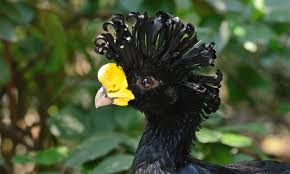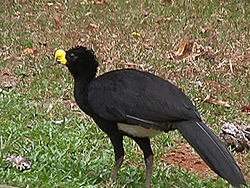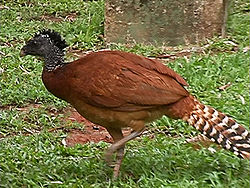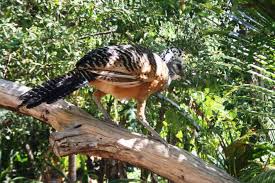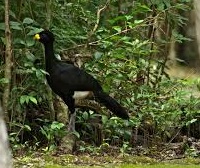The great curassow (Spanish: hocofaisán, pavón norteño) is a large, pheasant-like bird from the Neotropical
rainforests, its range extending from eastern Mexico, through Central America to western Colombia and
northwestern Ecuador. Male birds are black with curly crests and yellow beaks; females come in three colour
morphs, barred, rufous and black. These birds form small groups, foraging mainly on the ground for fruits and
arthropods, and the occasional small vertebrate, but they roost and nest in trees. This species is
monogamous, the male usually building the rather small nest of leaves in which two eggs are laid. This
species is threatened by loss of habitat and hunting, and the International Union for Conservation of
Nature has rated its conservation status as "vulnerable".
Description
At 78-100 cm (31-39 in) in length and 3.1-4.8 kg (6.8-10.6 lb) in weight, this is a very large cracid.
Females are somewhat smaller than males. It is the most massive and heavy species in the family but its
length is matched by a few other cracids. Four other species of curassow (the northern helmeted, the southern
helmeted, the black and the crested) are all around the same average length as the great curassow. In this
species, standard measurements are as follows: the wing chord is 36 to 42.4 cm (14.2 to 16.7 in), the tail
is 29 to 38 cm (11 to 15 in) and the tarsus is 9.4 to 12 cm (3.7 to 4.7 in). They have the largest mean
standard measurements in the family, other than tail length.
The male is black with a curly crest, a white belly, and a yellow knob on its bill. There are three morphs of
female great curassows: barred morph females with barred neck, mantle, wings and tail; rufous morph with an
overall reddish brown plumage and a barred tail; and dark morph female with a blackish neck, mantle and tail
(the tail often faintly vermiculated), and some barring to the wings. In most regions only one or two morphs
occur, and females showing a level of intermediacy between these morphs are known
(e.g. resembling rufous morph, but with black neck and faint vermiculations to the wings).
This species has a similar voice to several other curassows, its call consisting of a "peculiar" lingering
whistle.
Macho
Hembra
Habitat
While the range of the great curassow extends from southern Mexico to western Ecuador, their habitat is
usually limited to national parks and reserves. They build their nests of leaves and twigs in the forks
and depressions of trees. The male curassow leads his family and whistles when there are signs of danger.
Females lay two eggs at a time. Curassows are monogamous and travel in pairs or in small groups. The group
can communicate by grunting. Like chickens, they tend to run rather than fly.
Diet
The curassow finds its food by foraging on fallen fruits, berries and seeds. Additionally they may scrape
the ground in search of insects or small animals.
Threats
Deforestation of tropical forests is the major threat to the survival of the great curassow. Humans are a
direct threat to the great curassow because the local inhabitants hunt them for food. Besides humans,
snakes are also their predators.
Ecology
A monogamous species, the great curassow is distributed in rainforest from eastern Mexico throughout Central
America, to western Colombia and northwest Ecuador.[3] In Mexico, it is absent from drier western coastal
forests but does occasionally occur in dry areas of the Yucatan, Cozumel Island and Costa Rica. The great
curassow spends much of its time on the ground, but nests and roosts in trees. This species is gregarious,
occurring in groupings of up to a dozen birds, though occasionally birds can be seen alone. Its diet consists
mainly of fruits, figs and arthropods. Small vertebrates may supplement the diet on occasion, including
small mammals (such as rodents). Unlike other cracids, such as guans, they feed largely on fallen
fruit rather than pluck fruit directly from the trees. In Tamaulipas, it feeds largely on the fruit Spondias
mombin. Elsewhere, it may prefer the red berries of Chione trees.
The male great curassow may build the nest and attract a female's attention to it, though in other cases
both members of a pair will build the nest structure. Two eggs are typically laid in a relatively small
nest (usually made largely of leaves), each egg measuring 9.1 cm × 6.7 cm (3.6 in × 2.6 in) and weighing
200 g (7.1 oz). The young curassow weighs 123 g (4.3 oz) upon hatching; 2,760 g (6.08 lb) as a
half-year-old immature fledgling; and by a year of age, when fully fledged and independent of parental
care, will be about three-quarters of their adult weight at 3,600 g (7.9 lb). This species has been noted
for its rather aggressive temperament, which has been regularly directed at humans when the birds are held
in captivity. Undoubtedly, they have this inclination in order to repel natural predators, from both
themselves and their offspring. Known natural predators of this species have included ocelots and ornate
hawk-eagles, though chicks and eggs likely have a broader range of predators. When a potential predator is
near their offspring, curassows have been noted to engage in a distraction display, feigning injury. When
attacking humans, the curassows leap in fluttering flight and scratch about the head, targeting the eyes.
Their lifespan in captivity has reached at least 24 years.



